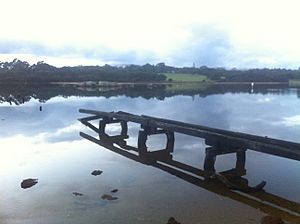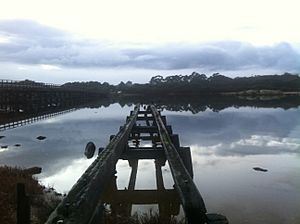Government Jetty, Albany facts for kids
The Government Jetty, also known as the Kalgan River Jetty or the Fruit Landing, is a special old structure. You can find it on Nanarup Road, right by the Kalgan River near Albany. This area is in the Great Southern region of Western Australia. It's considered a heritage site, meaning it's an important part of history.
Contents
What Was the Government Jetty Used For?
This jetty was built a long time ago, between 1906 and 1908. It was a key part of developing the area around the Lower Kalgan Bridge.
Helping New Settlers
The main idea behind building the jetty was to help new settlers. It was a place where special boats called lighters could dock. These boats would bring goods and supplies for the people settling in the district.
Building the Bridge
Later on, the jetty became very important for building the Lower Kalgan Bridge. Timber, or wood, needed for the bridge was delivered here. The jetty even had train tracks on it! This meant a trolley could be used to move heavy materials from the barges that brought them down the river.
Water for the Town
In 1914, the jetty was used for another big project. It helped bring in equipment like wooden and cast iron pipes. These were needed to build the town's water supply line, which came all the way from Two Peoples Bay.
A Stop for Tourists
The Government Jetty wasn't just for work; it was also a popular spot for tourists! Companies like Messrs Armstrong and Waters used it as a stop for their steamer, the Silver Star. This boat would bring sightseers from Albany. From the jetty, passengers would switch to smaller motor launches to explore further up the river to a place called Killarney.
How the Jetty Was Built
The jetty was designed as a "finger jetty" with a T-shaped end. It was made using strong timber poles, called pylons, and wooden decking. Everything was held together with iron fastenings.
Current Condition
Today, the jetty is not in very good shape. About 10 meters (or 33 feet) of it have been lost. Only parts of two of the original pylons remain.
Images for kids





